Coordinators:
Amar Ayyash (US)
Bruce Mactavish (Canada)
Dave Brown (Canada)
Mars Muusse (Netherlands)
smith rings
smith PDF's
smith 1cy August
smith 1cy September
smith 1cy October
smith 1cy November
smith 1cy December
smith 2cy January
smith 2cy February
smith 2cy March
smith 2cy April
smith 2cy May
smith 2cy June
smith 2cy July
smith 2cy August
smith 2cy September
smith 2cy October
smith 2cy November
smith 2cy December
smith 3cy January
smith 3cy February
smith 3cy March
smith 3cy April
smith 3cy May
smith 3cy June
smith 3cy July
smith 3cy August
smith 3cy September
smith 3cy October
smith 3cy November
smith 3cy December
smith sub-ad January
smith sub-ad February
smith sub-ad March
smith sub-ad April
smith sub-ad May
smith sub-ad June
smith sub-ad July
smith sub-ad August
smith sub-ad September
smith sub-ad October
smith sub-ad November
smith sub-ad December
smith ad January
smith ad February
smith ad March
smith ad April
smith ad May
smith ad June
smith ad July
smith ad August
smith ad September
smith ad October
smith ad November
smith ad December
|
American Herring Gull 4cy May
Third-summer similar to third-winter, but brown on upperwing-coverts fades, combined with new blackish feathers, creating piebald pattern. White primary tips reduced or lacking. Bill as second-winter, but often with extensive dark yellow behind nail. (Malling Olsen, K. & Larsson, H. 2004 Gulls of Europe, Asia and North America. London: Christopher Helm).
The Peterson Reference Guides
GULLS OF THE AMERICAS
- Steve N.G. Howell / Jon Dunn -
Below is a copy of chapter 25 about American Herring Gull, illustrated with images from this website. "we" in the text below refers to the original authors.
If any errors occur in this text, please let me know and mail to marsmuusseatgmaildotcom.
American Herring Gull (smithsonianus)
PART 1: IDENTIFICATION SUMMARY
PART 2: FIELD IDENTIFICATION - ADULT CYCLE
PART 3: FIELD IDENTIFICATION - FIRST CYCLE
PART 4: FIELD IDENTIFICATION - SECOND & THIRD CYCLE
PART 5: RARER SPECIES (BELOW)
RARER SPECIES
Also see hybrid American Herring Gull accounts (pp. 482-485, 490 in Gulls of the Americas).
Adult Cycle.
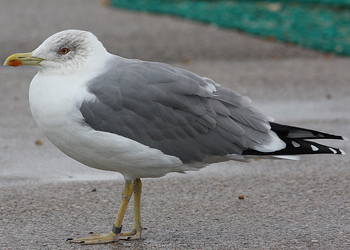 |
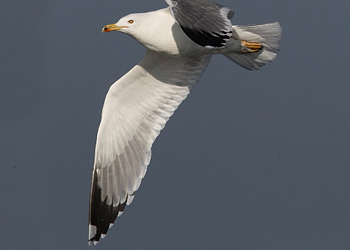 |
Yellow-legged Gull (michahellis) 22CY C53597 November 06 2013, Boulogne-sur-Mer, France (Jean-Michel Sauvage). Banded June 1992 in Itay. P9 fully grown, P10 growing by early November. Upperparts Kodak 7-8. Yellow legs. This is about the maximum head streaking for adult michahellis in winter. |
Yellow-legged Gull michahellis adult, January 02 2011, Mamaia, Romania (Chris Gibbins). Short pale tongue on P10 and full band on P10 and P5. |
 |
 |
| Atlantic Yellow-legged Gull (atlantis) adult, October 05 2011, Azores Islands (Rony Livne). Early October, already P8 fully grown. Taxon atlantis develop a streaked hood, especially on sub-adults. |
Atlantic Yellow-legged Gull (atlantis) adult, January 29 2008, Azores Islands (Dominic Mitchell). Ready to start the breeding season.White head. Saturated bare parts. Kodak 8 grey tone in upperparts. |
YELLOW-LEGGED GULL (casual e. N. America) similar in overall size and structure, although atlantis subspecies averages shorter legged and longer winged than Herring (more like Lesser Black-backed). Note slightly darker gray upperparts (Kodak 6-7 on michahellis, 7-8.5 on atlantis), reddish orbital ring, yellowish legs, relatively reduced dusky head streaking in winter (mostly on head), more extensive black wingtip, and earlier molt timing (so looks whiter headed in winter).
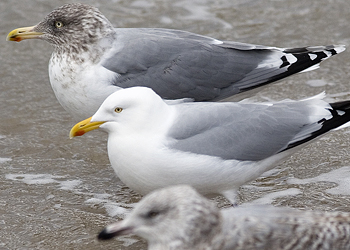 |
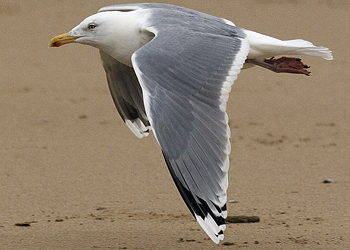 |
Herring Gull (argentatus) adult, February 07 2013, Katwijk, the Netherlands (Mars Muusse). Dark argentatus from Scandinavia, and adult argenteus (argenteus and smithsonianus about equal in grey tone). P10: Mirror merges with tip, P9 with large mirror, no black spot on P5. |
Herring Gull (argentatus) adult, February 14 2012, Noordwijk, the Netherlands (Mars Muusse). Thayeri pattern on P9 and P10, broken band on P7 and only faint black spots on P6. Probably from N Scandinavia. About Kodak 6-7 grey tone. |
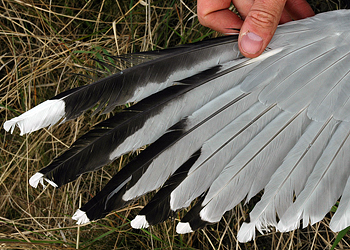 |
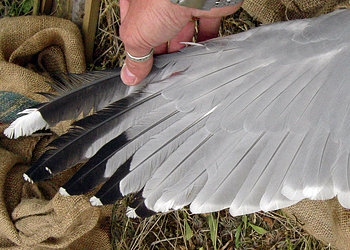 |
| Herring Gull (argenteus) female 11CY HL May 04 2006, Moerdijk, the Netherlands (Mars Muusse). If argenteus has a deep tongue on P10, there is no sub-terminal black on P10. No "bayonets" on P7-P8, no drawn-out W shape on P6 and no W shape on P5 are features different from many Newfoundland smithsonianus. |
Herring Gull (argenteus) male 8CY NE May 16 2006, Moerdijk, the Netherlands (Mars Muusse). Short tongue on P10 and no sub-terminal black on P10. No "bayonets" on P7-P8, but blunt ending black onouterweb. |
 |
 |
Herring Gull (argenteus) female adult 1V May 05 2005, Moerdijk, the Netherlands (Mars Muusse). Some argenteus have thayeri on P9 or P10, always in combination with limited sub-terminal black. No "bayonets" on P7-P8, no drawn-out W shape on P6 and no W shape on P5 are features different from many Newfoundland smithsonianus. |
Herring Gull (argenteus) female 23CY YAJP March 24 2010, IJmuiden, the Netherlands (Mars Muusse). Banded in 1987 in the Netherlands. Female argenteus less bulky than smithsonianus. |
 |
 |
| Herring Gull (argenteus) female adult YAKS January 30 2010, IJmuiden, the Netherlands (Mars Muusse). Banded in 2009 as breeding adult. Whole winter hardly developed winter streaking. The orbital ring is yellow-orange, and there is some black on the bill. Both features are commonly found in western argenteus. |
Herring Gull (argenteus) female 5CY FJAK November 09 2010, Boulogne-sur-Mer, NW France (Jean-Michel Sauvage).Banded in 2006 in Belgium. P10 fully grown. Smithsonianus develops more winter streaking than argenteus and sub-adults have more streaking than old adults. This 5th cycle argenteus has neat delicate straeking. |
EUROPEAN HERRING GULL (casual e. N. America). Nominate argentatus similar in size and shape to smithsonianus but differs in slightly darker upperparts (Kodak 5.5-7), wingtips generally show extensive white areas, P5 often lacks black marks, and some birds have fleshy yellow to yellowish legs. Race argenteus averages smaller than smithsonianus but upperparts similar in tone (Kodak 4-5), and these two taxa not separable given present knowledge concerning variation in American Herring Gull. Some reliable differences in wingtip patterns may exist between these taxa, but this needs further study incorporating birds from throughout N. America. (Adriaens & Mactavish 2004) Adult-type smithsonianus can show blackish tertial spots, not known in European Herring Gulls. (Lonergan & Mullarney 2004)
First Cycle.
YELLOW-LEGGED GULL has whiter head and underparts, brighter white uppertail coverts and tail base with narrower black distal tail band (more like Lesser Black-backed Gull), overall dark primaries with indistinct paler panel on inners, more solidly dark bases of greater coverts, blackish bill, and averages narrower tertial edgings. PA1 in nominate michahellis often includes upperwing coverts and even tertials by early winter.
 |
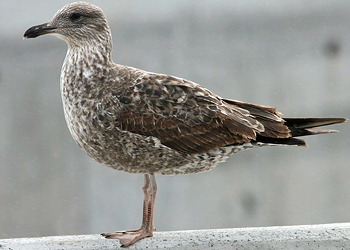 |
Yellow-legged Gull (michahellis) 1st cycle U0AB February 04 2011, Ashdod, Israel (Amir Ben Dov). Banded in Tel Aviv. White-headed. Several MC, LLC and LC replaced for 2nd gen feathers. Juvenile wing-coverts strongly worn. |
Yellow-legged Gull (atlantis) 1st cycle, February 2010, Azores Islands (Peter Alfrey). Atlantis much more mottled. All scapulars are 2nd gen. Also replaced TT2, inner GC, inner MC, inner LLC and about 1/3 of the visible LC. Note replaced body feathers at flanks, side of the neck and head. |
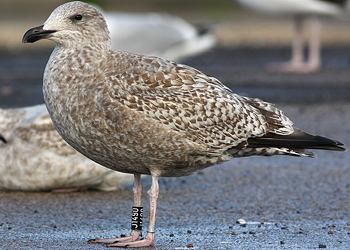 |
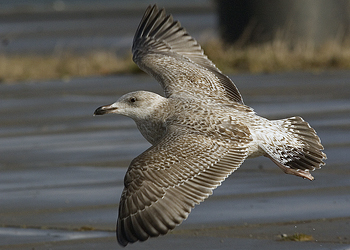
|
Herring Gull (argentatus) 1st cycle J1490 November 27 2011, Boulogne-sur-Mer, France (Jean-Michel Sauvage). Banded in NE Norway (70°N). Most scapulars still juvenile. Argentatus match smithsonianus in jizz and sometimes in underpart texture, still, widely spaced undertail coverts and much proximal white in tail. Also delicate streaking on head and in neck. |
Herring Gull (argentatus) 1st cycle C-730184 December 09 2010, IJmuiden, the Netherlands (Mars Muusse). Banded in N Russia (67°N). Upper scapulars 2nd gen, lower scapulars still juvenile. Largely pale rump, uppertail coverts and bases of rectrices. |
 |
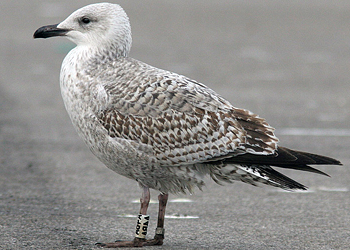 |
Herring Gull (argenteus) 1st cycle XY1T December 03 2012, Boulogne-sur-Mer, France (Jean-Michel Sauvage). Banded in London in winter. All scaps 2nd gen, except rear lower scapulars. Wide spacing on undertail coverts. Pale underparts with delicate streaks. |
Herring Gull (argenteus) 1st cycle A4BA November 24 2006, Boulogne-sur-Mer, France (Mars Muusse). Banded in U.K. All scaps 2nd gen, except rear lower scapulars. Wide spacing on undertail coverts, much proximal white on rectrices, very pale headed. Delicate streaking in neck. |
 |
 |
| Herring Gull 1st cycle, December 03 2013, Katwijk, the Netherlands (Mars Muusse). Scapulars 2nd gen. Largely pale rump, uppertail coverts and bases of rectrices. |
Herring Gull 1st cycle, January 23 2013, Katwijk, the Netherlands (Mars Muusse). Pale undertail coverts and head. No smooth, washed out texture on underparts, instead much lining and spotting. |
EUROPEAN HERRING GULL paler and frostier overall, typically with paler underparts not strongly washed brown, whiter tail coverts and tail base more sparsely barred brown, tail with narrower dark distal band, and inner primaries with less-extensive dark subterminal marks. Outer primaries of some nominate argentatus, at least, have more-extensive paler inner webs and may show pale tongue-streaks, as opposed to more solidly dark outer primaries typical of American Herring.
 |
 |
Kelp Gull (dominicanus) 1st cycle, June 26 - July 06 2013, SW Cape Province of South Africa. Picture: Chris Gibbins. African taxon vetula. Pale undertail coverts. Some resemblance to Lesser Black-backed Gull. |
Kelp Gull (dominicanus) 1st cycle, June 26 - July 06 2013, SW Cape Province of South Africa. Picture: Chris Gibbins. African taxon vetula. All dark tail contrast with pale uppertail coverts. Dark inner primaries resemble Lesser Black-backed Gull. Note replaced inner coverts. |
KELP GULL (S. America) has dull, dusky flesh legs, lacks contrasting pale panel on inner primaries, and has more sparsely barred and more-contrasting white uppertail coverts.
Second Cycle.
YELLOW-LEGGED GULL typically has less contrasting pale panel on inner primaries, any plain gray on upperparts is slightly darker, greater coverts typically paler overall and more coarsely patterned (often fairly dark brownish overall on American Herring), and tail averages less-extensive black (more like third-cycle American Herring).
 |
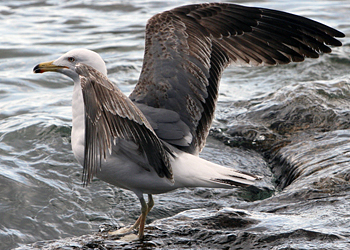 |
Yellow-legged Gull (michahellis) 2nd cycle, November 24 2006, Etaples, France (Mars Muusse). Classic 2nd cycle. Partial autumn moult included upper TT, inner GC, central MC en random LLC and LC. |
Atlantic Yellow-legged Gull (atlantis) 2nd cycle, February 19 2009, Canary Islands (Asier Aldalur). 2nd gen primaries with a brownish wash, without a mirror on P10, 4 coloured bill, pale iris, dark grey upperparts. |
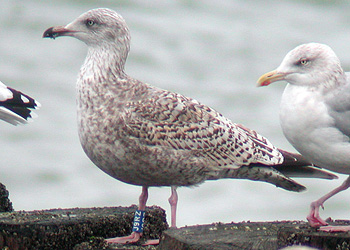 |
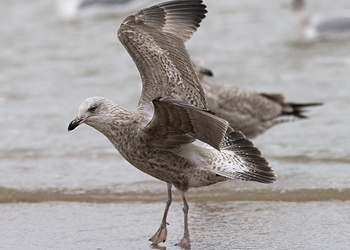 |
| Herring Gull (argentatus) 2nd cycle J9RZ November 01 2007, Westkapelle, the Netherlands (Pim Wolf). Banded in NE Norway (70°N). Resembling 1st cycle, but pale eye and mirror on underside of 2nd gen P10. Much white in tail and pale underparts. |
Herring Gull (argentatus) 2nd cycle, November 26 2013, Katwijk aan Zee, the Netherlands (Mars Muusse). Complete moult finished. Unringed, hence no provenance on origin but overall coloration and jizz suggest nominate argentatus. Pale rump. |
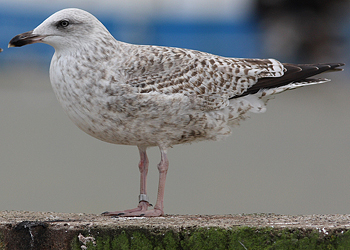 |
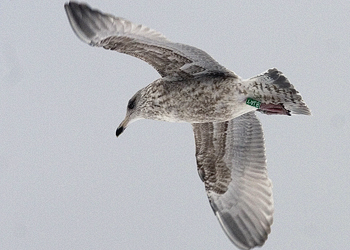 |
| Herring Gull (argenteus) 2nd cycle GR20814 November 28 2012, Boulogne-sur-Mer, France (Jean-Michel Sauvage).
Banded in the U.K. Pale eye and chequered tertial centres and greater coverts. Much white in tail, undertail coverts and pale underparts. |
Herring Gull (argenteus) 2nd cycle YALB December 23 2010, IJmuiden, the Netherlands (Mars Muusse). Banded as pullus in 2009. Pale iris, pale base of bill and typical checkered pattern of 2nd gen secondaries. Pale undertail coverts with wide spacing, pale base of outer rectrices. Spotted underparts. |
EUROPEAN HERRING GULL averages less-extensive black on tail (more like many third-cycle American Herrings) and greater coverts typically paler overall and more patterned (often fairly dark brownish overall on American Herring), but some individuals may overlap in pattern; also note slightly darker gray upperparts of nominate argentatus. Study needed of distinguishing features.
KELP GULL has distinctly darker upperparts, upperwing lacks contrasting pale panel on inner primaries, and tail averages less black (more like third-cycle Herring); winter bill often black, tipped creamy, becoming adult-like by summer; legs dusky flesh to dull greenish.
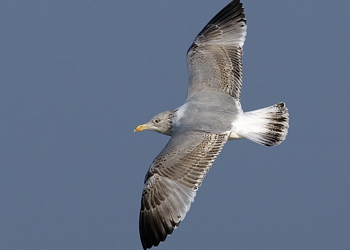 |
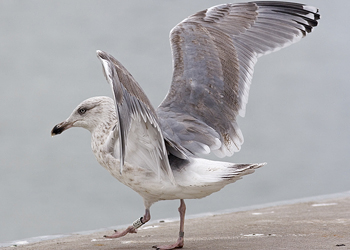 |
Herring Gull 3rd cycle, January 23 2013, Katwijk, the Netherlands (Mars Muusse). 3rd and 4th cycles difficult to separate in many cases, but a single small mirror on P10, much dark in secondaries & tail, and extensive brown coverts is generally associated with 3rd cycle birds. All secondaries and rectrices patterned, but no sharp defined black ink-spots as in smithsonianus; instead often with vermiculation and paler, brownish. |
Herring Gull (argentatus) 3rd cycle KH89 October 31 2011, IJmuiden, Netherlands (Mars Muusse). Banded as pullus in 2009 in N Russia (70°N). Thayeri pattern on P9. Clean rump and white underparts. |
Third Cycle.
Yellow-legged Gull and European Herring Gull differ in much the same ways as do adults (see above and relevant accounts); both lack extensive brownish mottling on underparts, which is often shown by American Herring. European Herring rarely if ever has solidly blackish tertial centers and well-defined blackish marks on the secondaries (shown by many third-cycle American Herring Gulls), and averages bolder white tips to outer primaries. (Lonergan & Mullarney 2004)
HABITAT & BEHAVIOR
Widespread and adaptable. In the East this is the common large “seagull” found on beaches, at estuaries, fishing harbors, dumps, and parking lots, ranging offshore over shelf waters and inland to lakes, rivers, farmland, etc. It is also common around the Great Lakes and locally on larger lakes and rivers in the interior. On the West Coast it is more local than in the East, favoring inland areas and offshore waters rather than the immediate coast (where Western and Glaucous-winged Gulls dominate). Nests colonially or in scattered pairs on inshore coastal islands and islets, islands in lakes, locally on buildings. Nonbreeding birds often in flocks (locally up to a few thousand birds), associating readily with other gulls and water birds. Feeds commonly by scavenging; also forages in intertidal and surface waters for marine invertebrates, and preys on eggs and young birds.
CONTINUE PART 6: DESCRIPTION & MOLT |
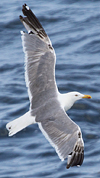 Hybrid smithsonianus x graellsii F07 1st & 3rd cycle, July - August 2011 & May 2014, Appledore Island, NH. Hybrid smithsonianus x graellsii F07 1st & 3rd cycle, July - August 2011 & May 2014, Appledore Island, NH. |
 American Herring Gull (smithsonianus)
American Herring Gull (smithsonianus) Hybrid smithsonianus x graellsii F07 1st & 3rd cycle, July - August 2011 & May 2014, Appledore Island, NH.
Hybrid smithsonianus x graellsii F07 1st & 3rd cycle, July - August 2011 & May 2014, Appledore Island, NH. American Herring Gull (smithsonianus) sub-adult, May 20 2013, Appledore Island, ME. Picture: Shailee Shah.
American Herring Gull (smithsonianus) sub-adult, May 20 2013, Appledore Island, ME. Picture: Shailee Shah.  American Herring Gull (smithsonianus) sub-adult, May 25 2012, Monhegan Island, Lincoln Co., Maine. Picture: Jonathan Mays.
American Herring Gull (smithsonianus) sub-adult, May 25 2012, Monhegan Island, Lincoln Co., Maine. Picture: Jonathan Mays. American Herring Gull (smithsonianus) sub-adult, May 26 2011, Merritt Island, FL, USA. Picture: Hart Rufe.
American Herring Gull (smithsonianus) sub-adult, May 26 2011, Merritt Island, FL, USA. Picture: Hart Rufe.




























